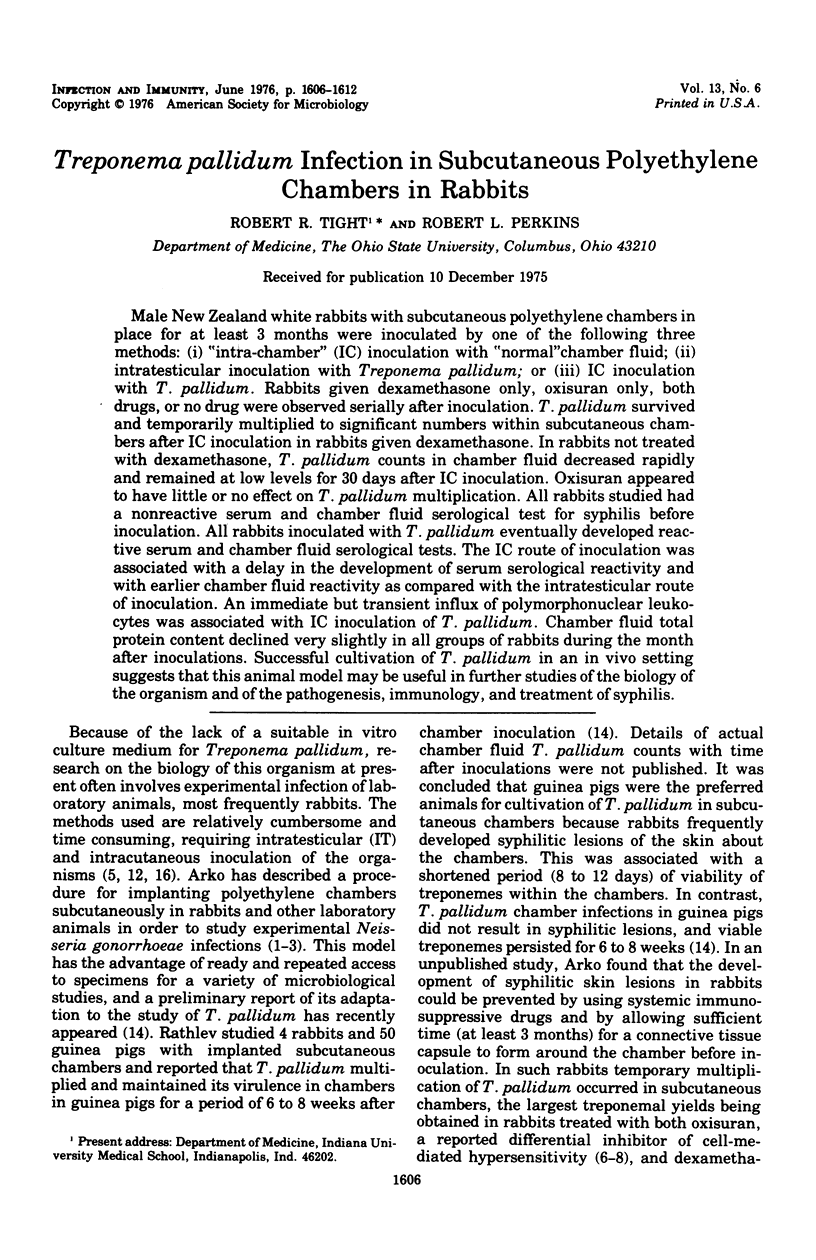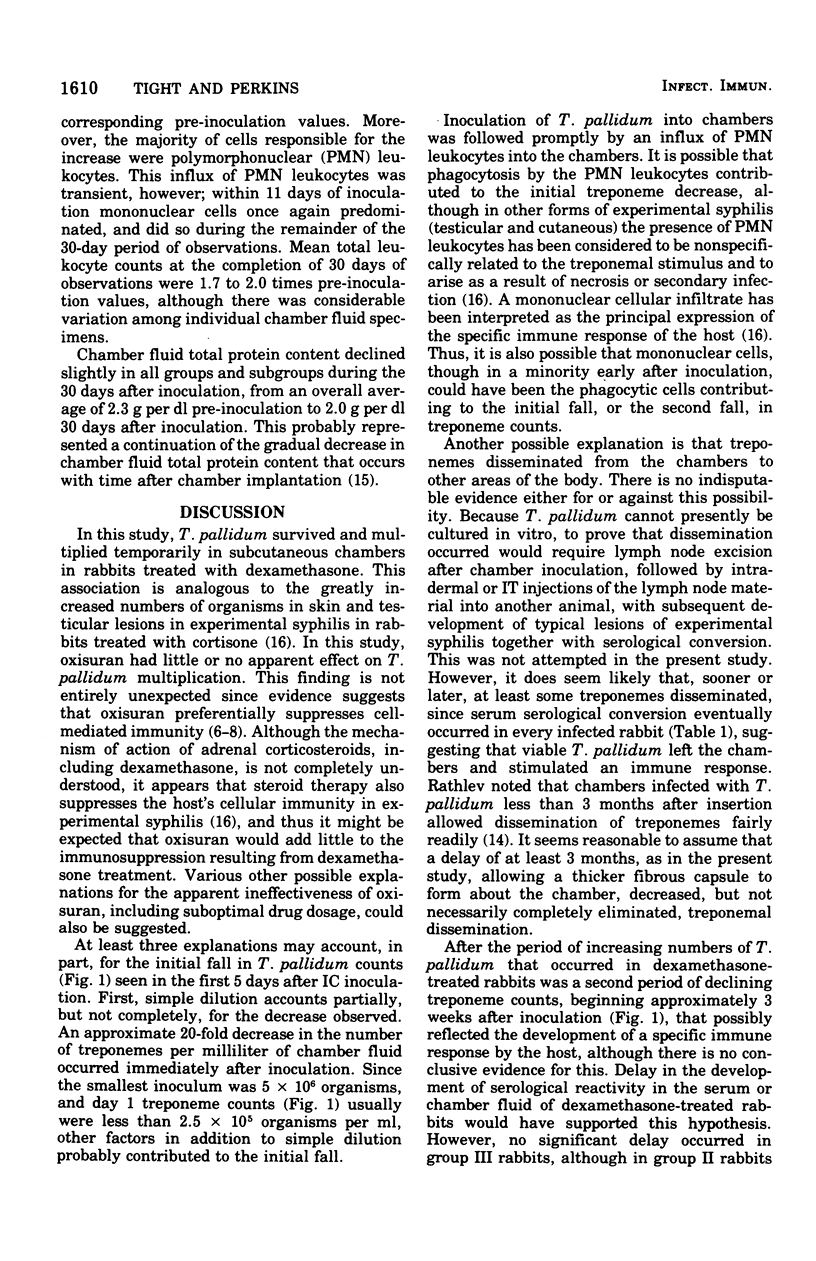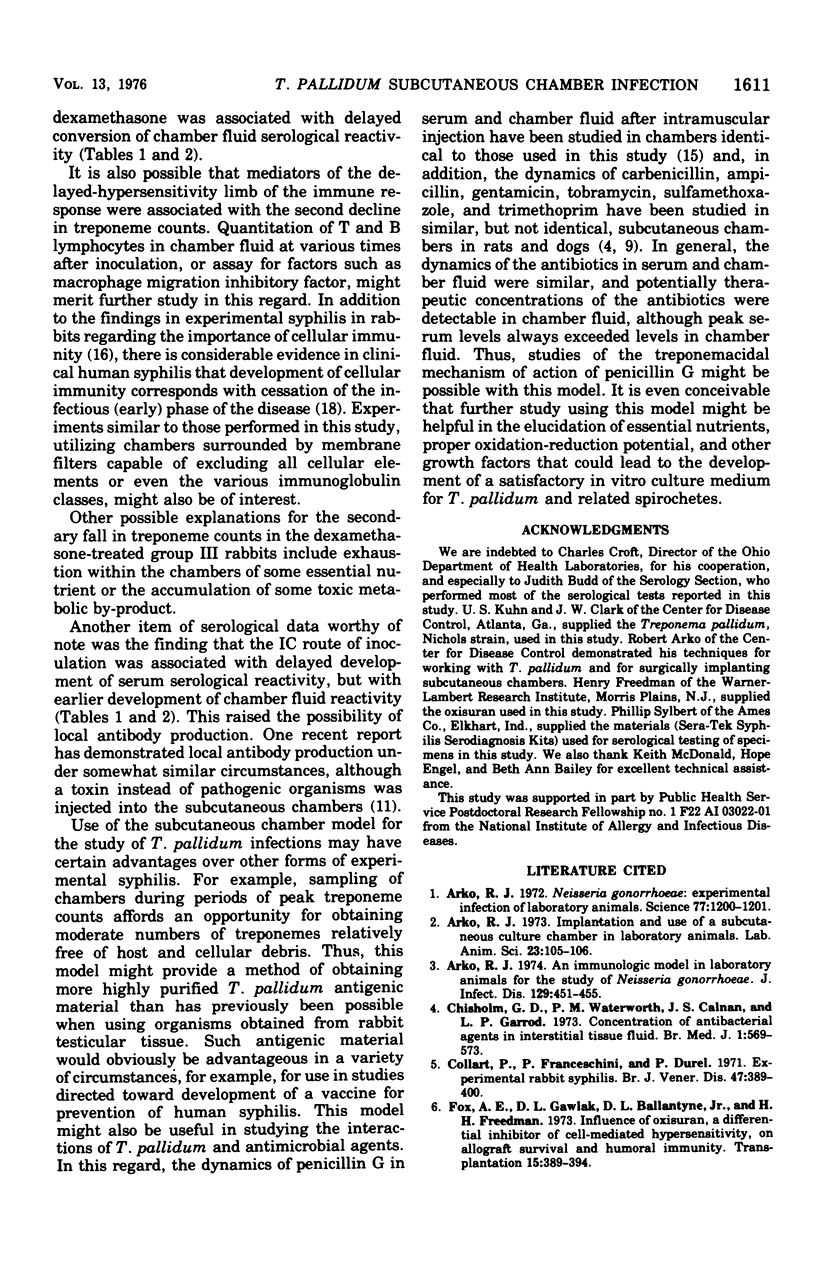Abstract
Male New Zealand white rabbits with subcutaneous polyethylene chambers in place for at least 3 months were inoculated by one of the following three methods: (i) "intra-chamber" (IC) inoculation with "normal" chamber fluid: (ii) intratesticular inoculation with Treponema pallidum; or (iii) IC inoculation with T. pallidum. Rabbits given dexamethasone only, oxisuran only, both drugs, or no drug were observed serially after inoculation. T. pallidum survived and temporarily multiplied to significant numbers within subucutaneous chambers after IC inoculation in rabbits given dexamethasone. In rabbits not treated with dexamethasone, T. pallidum counts in chamber fluid decreased rapidly and remained at low levels for 30 days after IC inoculation. Oxisuran appeared to have little or no effect on T. pallidum multiplication. All rabbits studied had a nonreactive serum and chamber fluid serological test for syphilis before inoculation. All rabbits inoculated with T. pallidum eventually developed reactive serum and chamber fluid serological tests. The IC route of inoculation was associated with a delay in the development of serum serological reactivity and with earlier chamber fluid reactivity as compared with the intratesticular route of inoculation. An immediate but transent influx of polymorphonuclear leukocytes was associated with IC inoculation of T. pallidum. Chamber fluid total protein content declined very slightly in all groups of rabbits during the month after inoculations. Successful cultivation of T. pallidum in an in vivo setting suggests that this animal model may be useful in further studies of the biology of the organism of the pathogenesis, immunology, and treatment of syphilis.
Full text
PDF






Selected References
These references are in PubMed. This may not be the complete list of references from this article.
- Arko R. J. An immunologic model in laboratory animals for the study of Neisseria gonorrhoeae. J Infect Dis. 1974 Apr;129(4):451–455. doi: 10.1093/infdis/129.4.451. [DOI] [PubMed] [Google Scholar]
- Arko R. J. Implantation and use of a subcutaneous culture chamber in laboratory animals. Lab Anim Sci. 1973 Feb;23(1):105–106. [PubMed] [Google Scholar]
- Arko R. J. Neisseria gonorrhoeae: experimental infection of laboratory animals. Science. 1972 Sep 29;177(4055):1200–1201. doi: 10.1126/science.177.4055.1200. [DOI] [PubMed] [Google Scholar]
- Chisholm G. D., Waterworth P. M., Calnan J. S., Garrod L. P. Concentration of antibacterial agents in interstitial tissue fluid. Br Med J. 1973 Mar 10;1(5853):569–573. doi: 10.1136/bmj.1.5853.569. [DOI] [PMC free article] [PubMed] [Google Scholar]
- Collart P., Franceschini P., Durel P. Experimental rabbit syphilis. Br J Vener Dis. 1971 Dec;47(6):389–400. doi: 10.1136/sti.47.6.389. [DOI] [PMC free article] [PubMed] [Google Scholar]
- Fox A. E., Gawlak D. L., Ballantyne D. L., Jr, Freedman H. H. Influence of oxisuran, a differential inhibitor of cell-mediated hypersensitivity, on allograft survival and humoral immunity. Transplantation. 1973 Apr;15(4):389–394. doi: 10.1097/00007890-197304000-00007. [DOI] [PubMed] [Google Scholar]
- Fox A. E., Gingold J. L., Freedman H. H. Inhibition by oxisuran of cell-mediated hypersensitivity by decrease in numbers of specifically sensitized cells. Infect Immun. 1973 Oct;8(4):549–554. doi: 10.1128/iai.8.4.549-554.1973. [DOI] [PMC free article] [PubMed] [Google Scholar]
- Freedman H. H., Fox A. E., Shavel J., Jr, Morrison G. C. Oxisuran: a differential inhibitor of cell-mediated hypersensitivity. Proc Soc Exp Biol Med. 1972 Mar;139(3):909–912. doi: 10.3181/00379727-139-36264. [DOI] [PubMed] [Google Scholar]
- Gardner W. G., Prior R. B., Perkins R. L. Fluid and pharmacological dynamics in a subcutaneous chamber implanted in rats. Antimicrob Agents Chemother. 1973 Aug;4(2):196–197. doi: 10.1128/aac.4.2.196. [DOI] [PMC free article] [PubMed] [Google Scholar]
- Hillam R. P., Tengerdy R. P., Brown G. L. Local antibody production against the murine toxin of Yersinia pestis in a golf ball-induced granuloma. Infect Immun. 1974 Sep;10(3):458–463. doi: 10.1128/iai.10.3.458-463.1974. [DOI] [PMC free article] [PubMed] [Google Scholar]
- Rathlev T. Cultivation of pathogenic Treponema pallidum in chambers surgically implanted in experimental animals. Acta Pathol Microbiol Scand B Microbiol Immunol. 1973 Apr;81(2):269–271. doi: 10.1111/j.1699-0463.1973.tb00223.x. [DOI] [PubMed] [Google Scholar]
- Tight R. R., Prior R. B., Perkins R. L., Rotilie C. A. Fluid and penicillin G dynamics in polyethylene chambers implanted subcutaneously in rabbits. Antimicrob Agents Chemother. 1975 Oct;8(4):495–497. doi: 10.1128/aac.8.4.495. [DOI] [PMC free article] [PubMed] [Google Scholar]
- Wright D. J., Grimble A. S. Why is the infectious stage of syphilis prolonged? Br J Vener Dis. 1974 Feb;50(1):45–49. doi: 10.1136/sti.50.1.45. [DOI] [PMC free article] [PubMed] [Google Scholar]


